Bicycle Touring Logistics: 1,000 Miles of Nuts and Bolts

A bee explores a sunflower as Chelsea whizzes past in the Plains.
Life on a bike tour is a simple existence, and over 1,000 miles cycling in the last few weeks, our daily existence has hit a rhythm of sorts. This post describes the different aspects of the day-to-day logistics underpinning the soaring views, descents off mountain passes and hanging with wonderful people. After all, surviving a journey like this requires staying on top of practical, boring tasks, even when we’re exhausted and grimy from a hard day of riding. Which is every day!
What’s Our Day Look Like?
Each day we aim to pedal our way 50-60 miles on quiet highways or back roads to our destination. Distance per day, with a peak so far of 74 and a low of 28, largely depends on elevation gain and whether there are any services to be had such as water, stores and restaurants. For example, we’ll ride 30 miles and then 65 the next day to avoid a huge day or dodge camping in an oil field or on a ranch where we wake up with a bull steer stomping on our face. Also, we didn’t bring a water filter because apparently filtering puddles filled with arsenic and pesticides will turn your oatmeal and hair green, so our no-services range is about 100 miles.
For those of you picturing us hammering straight through the day, let me quickly dispel that notion. Bike touring is about the journey! Breaks along the way, usually every hour or so, are for food, stretching or lying flat on our backs in the middle of a field, which is just as nice as it sounds unless there are mosquitoes or no shade. We stop anywhere that seems interesting, be it to wander around museums (still searching for the World’s Biggest Ball of Twine), eat (constantly), meet people (the weirder, the better) or simply catch a break from the taint-grinding of multi-day long-distance cycling.
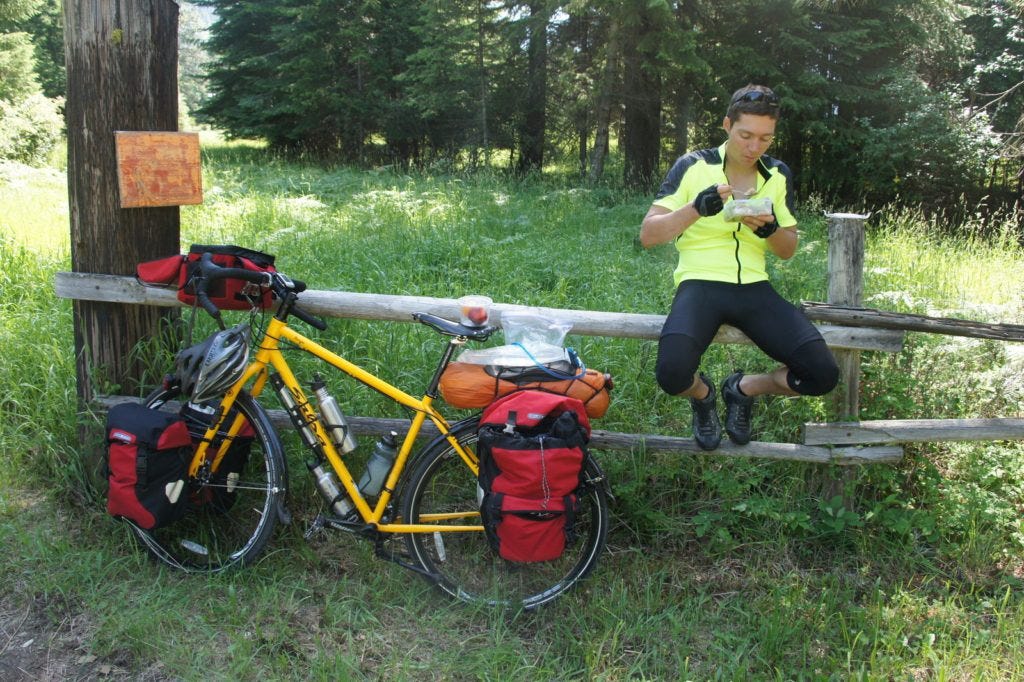
Catching a lunch break in SW Montana on a back road.
And so our days are spent pedaling for 4-8 hours and 10-12 hours from start to stop, passing through small towns of 50 people up to a few thousand. Rural America at its best! Let me say this: with that much time in the sun, tan lines quickly become a print model’s worst nightmare! We took another cyclist’s advice and picked up Pearl Izumi sun sleeves, which are white, lightweight cover-ups that slip on and prevent Scorched Arm Syndrome.
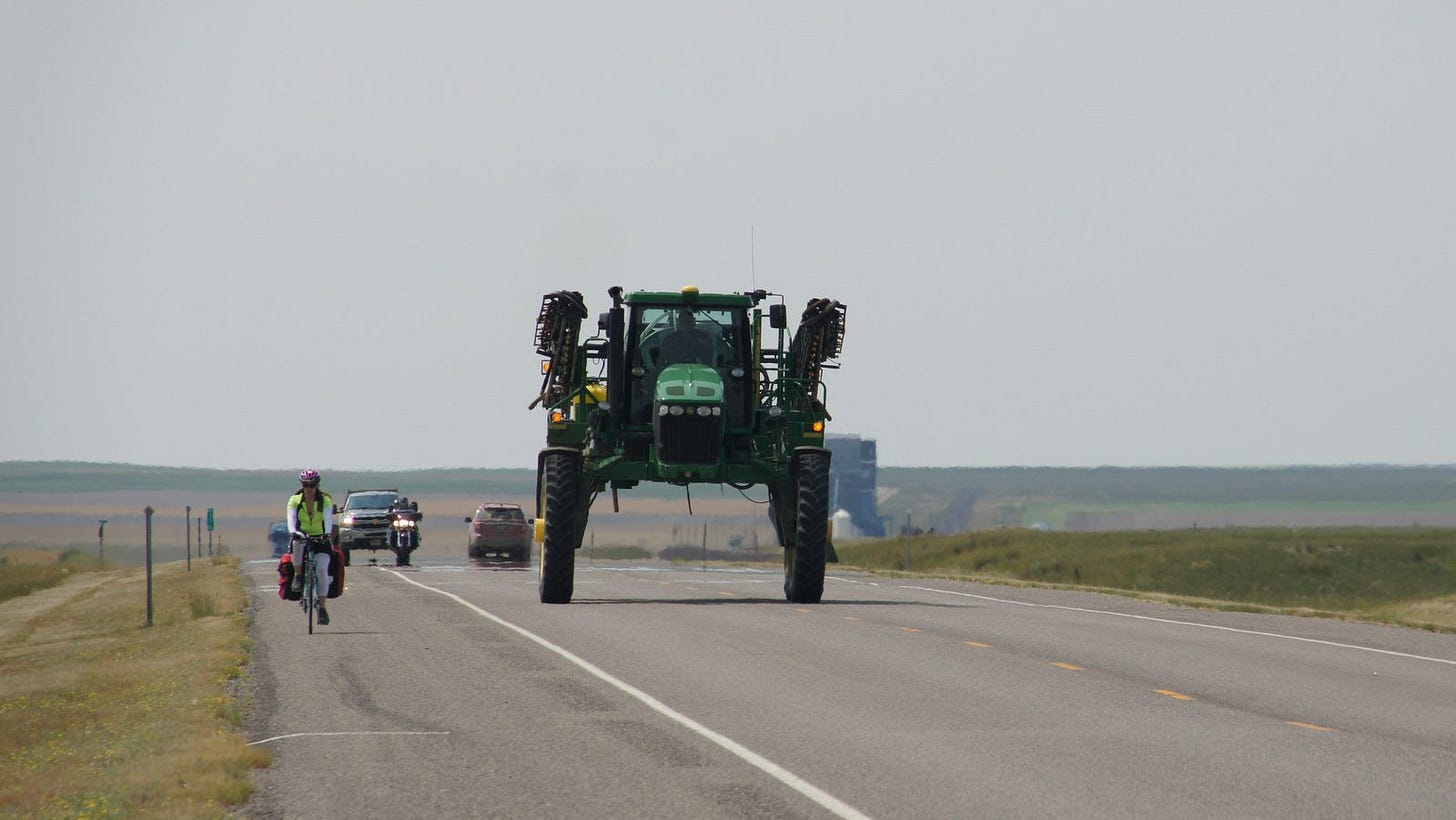
Chelsea and a giant piece of farm machinery share Highway 2 in northern Montana. A short stint on a busy stretch - most roads we cruise only have a few cars an hour on them.
The Basics
We wake up in the tent, or on a bed or floor in someone’s house or in the occasional hotel. Traveling long-term always requires me to take stock of my surroundings and recall where I am - “oh yeah, N. Montana today, not the van in SoCal.” Then I bounce out of bed to make breakfast while Chelsea clears out the tent. In an effort to avoid turning into a pencil-armed T-Rex with no upper body strength, some sets of push-ups, burpees and core exercises kick things off. An occasional hoot of derision from a passing pickup truck is well-deserved, I should add.
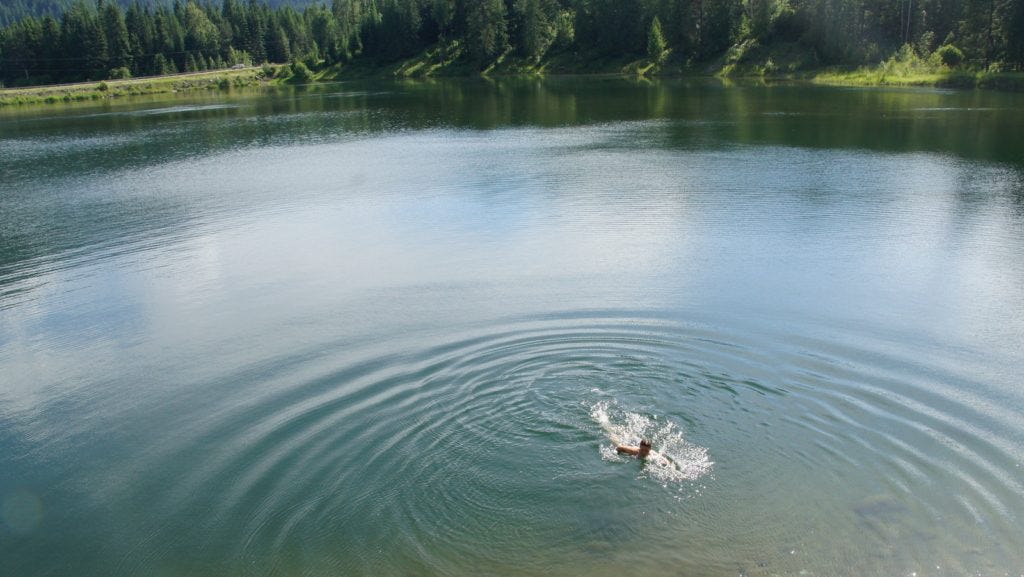
Showering off in a FREEZING lake in Montana.
Next, we break camp and hit the road. Wake up time depends on how late we were up with hosts the night before, and weather is a factor as well. If it’s going to be 95, we’re up earlier, with 5 the earliest so far. (Tough when it’s light until 10:30 at night this far north!) We’ve left as late as 11 on shorter days when the weather is cool. As we head east and August heat waves roll in, we’ll be up early for sure to beat headwinds and heat. No, I won’t put money on that. :)
Do You Sleep Under Picnic Tables in a Cardboard Box?
Nope, just out in the open clutching our bear spray with cycling shoes clipped into our pedals. Or in culverts hiding from the law, depending how the day went. Some are better than others out here in the Wild West.

Some nights, we make a lean-to teepee instead of pitching the tent.
Nah, we either camp, grab the occasional hotel when bleary eyes and tired legs need comfort, or stay at a gracious host’s home (Couchsurfing/Warm Showers/friend). Also worth mentioning is something we’ve discovered along the way: small city parks are open to anyone wanting to pitch a tent next to the jungle gym. Yep, even drifters like us with hunger-addled minds. It’s a reminder that people are so generous and open-hearted; city folks could learn a lot from rural America. We certainly are. Though our political beliefs may occasionally differ, we’re all human at our core and will go out of our way to help a stranger, even a sweaty one dressed in some weird Spandex outfit.

Thousands of hay bales are scattered across fields this time of year. We have yet to sleep in one of them...
Our gear is a mix of comfort and lightweight. The Big Agnes Copper Spur UL3 is a great three-person tent - more space and a bit more weight is so worth it for this many days on the road! We also have inflatable sleeping pads (Q Core SL) from Big Agnes that are comfortable and thick, yet pack down to a tiny size. Warning: they sound like a snorting walrus when you roll over on them at night. Chelsea has a 15 degree bag from Nemo and I’m rocking an REI original sleeping bag from her grandma. Works great, even if the weight suggests geese are still attached to the down.

Does all this stuff really fit in six panniers? Exploding Travel Gear Inc.
Couchsurfing and Warm Showers Rule
Traveling reinforces the fact that people are amazingly generous. They will invite complete strangers into their home and share their space as if we were family. A recent host wasn’t even home when we arrived - “just let yourself in” - and took off on a backpacking trip early the next morning while we stayed another day. For those of you we’ve stayed with during this trip, THANK YOU for being so awesome! We hope you can come stay with us someday.
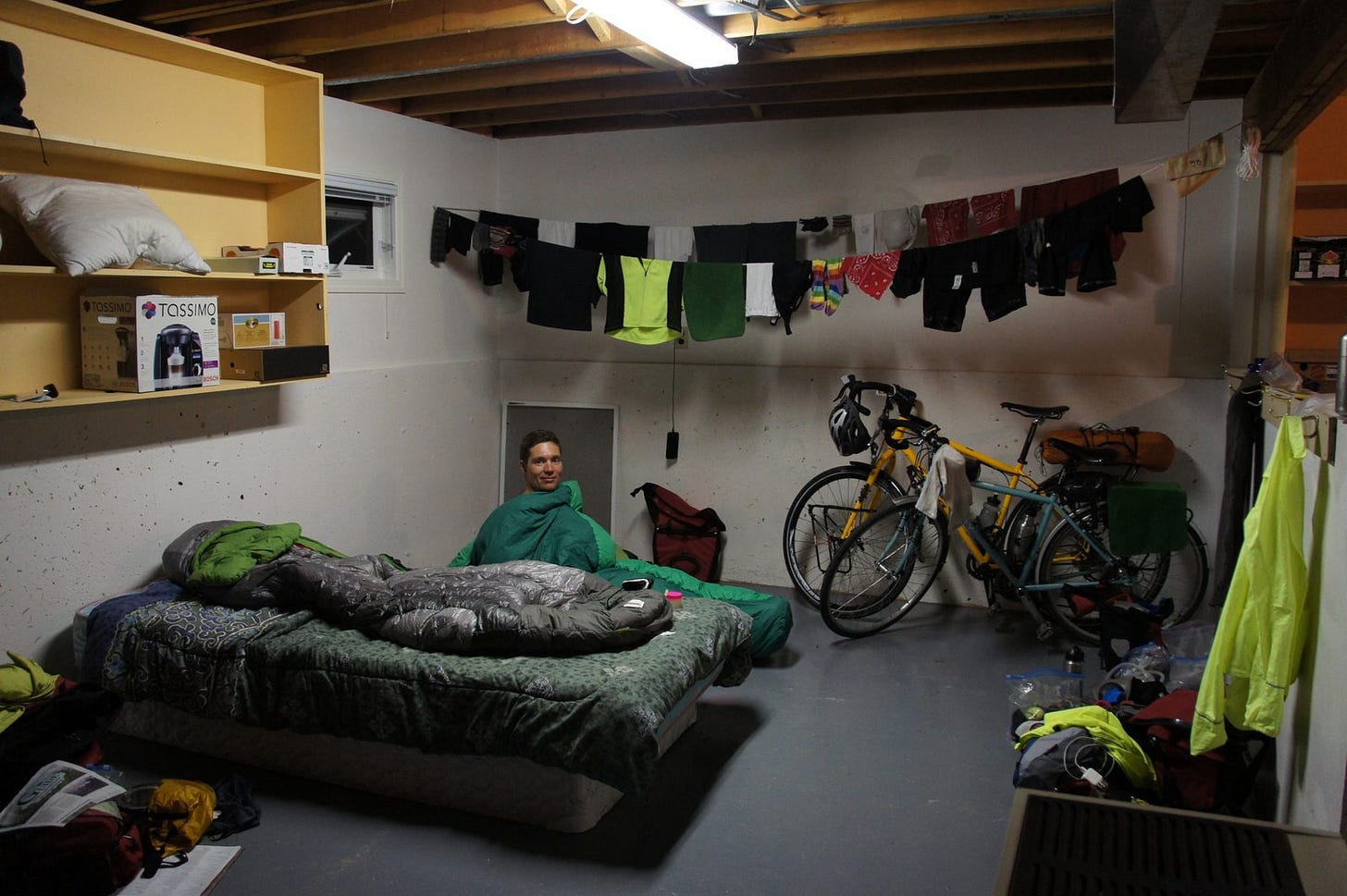
Dakota getting comfy on the floor in a host's basement in Canada. Thanks Sharon!
How Do You Ride with All that WEIGHT? UGH.
We do not (absolutely not!) ride with a heavy backpack, as a few have asked. Panniers are the way to roll! Also, numerous people have asked what it feels like riding with loaded rear and front panniers and a handlebar bag. “Dude, doesn’t that feel like a bloated hippopotamus squatting on your bike?!” Honestly, I initially had my misgivings, punctuated by whining and bellyaching. However, I’ve grown to dig my setup and my bike feels great while handling totally fine even at 35 mph downhill.
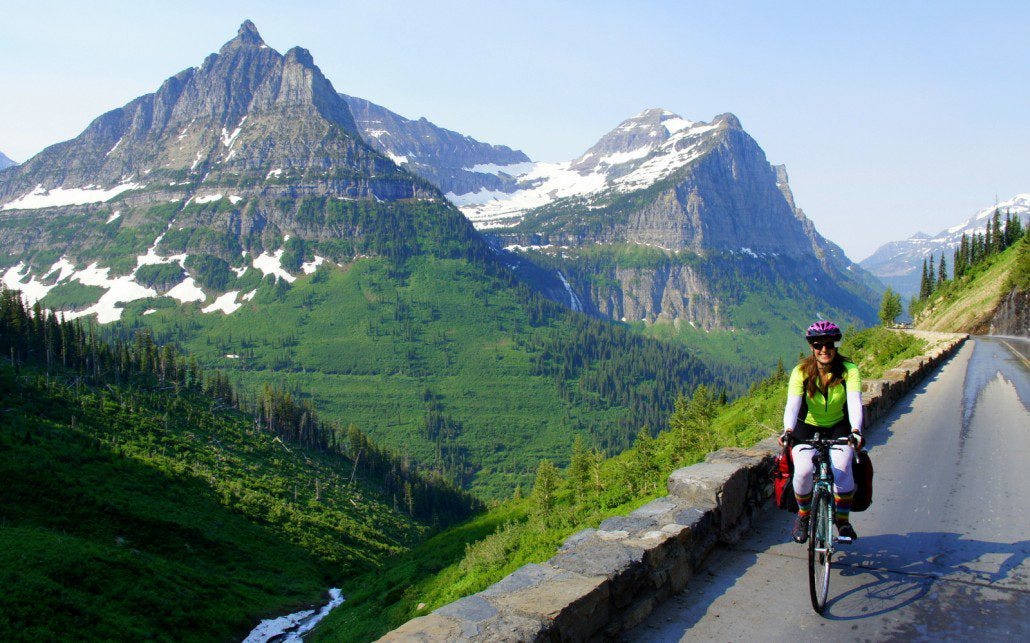
Was this really only a week ago? The Rockies quickly turned into the plains, that's for sure.
When we’re fully loaded and rolling, each of my front panniers has about six pounds in it. Left is my wardrobe in all its glory, right is the kitchen plus two packets of emergency backpacking food. Rear panniers are about 12 pounds each when they’re loaded down with tons of grub. Right rear is rain gear and sleeping kit, left is food, laptop and things we access a lot. The tent is strapped to my rear rack and we also both carry three water bottles plus a 3 liter water reservoir for long days, kept empty when we have access to towns.
Did You Bring Jeans and a Dress Shirt?

Washing laundry in the Sea to Summit expandable sink.
Negative, Ghost Rider. Clothing is fairly minimal. For riding, I have a few pairs of light socks, cycling shoes, two jerseys, two pairs of riding shorts, and sun sleeves/arm/leg warmers. For non-bike time, I’m carrying flip flops, two pairs of quick-dry underwear, three shirts, lightweight pants and shorts, and a down jacket for cold nights, which also doubles as Chelsea’s pillow. We certainly won’t be attending any white tie events along the way. Oh, and rain gear (jacket, pants, gloves and shoe covers), which we hadn’t used until a solid day riding in the rain and wind yesterday in Central Montana. Everything worked great!
To keep it all clean, every night we wash out that day’s riding gear in our Sea to Summit lightweight folding sink, which we then dry the next day under a cargo bungee net on our racks the next day. The Yard Sale, as we call it, though so far we haven’t sold anything. I can’t BELIEVE nobody wants my worn riding shorts.

Key components of my riding kit - sun sleeves, knee warmers, and bright jersey. Shot from the east side of Glacier inconveniently featured nine miles of road construction on gnarly roads. This was the view at least...rest break from dust and traffic cops.
What Are You Eating?
Food of the plant-power variety! A surprise to us, some organic produce and food is usually available in towns of 3,000+ people, which we encounter every few days. Otherwise, we’re in the “unincorporated township” realm a lot or 50-500 person towns with a bar that doubles as the post office...you can see how pickings might be slim. It’s a bit of a struggle sometimes, yet part of the experience and one we’re handling in stride.

Plant-powered snacking. Wishing we didn't have to buy packaged stuff, though we avoid it whenever possible.
Simple breakfasts of oatmeal or granola and then a mix of nuts and fruit (dried and fresh) for snacks throughout the day. I often have an entire bag of cherries or grapes in my handlebar bag to munch on during the day. Lunch is usually a rice, bean or lentil dish prepared the night before, leftovers from a previous meal stored in Tupperware or else we’ll stop to eat out. (Go-to vegan greasy spoon fare: home fries with “all the vegetables you’ve got!”) Same theme for dinner. Even burning 3,000 calories extra per day, I don’t wake up with my stomach trying to crawl out of my body in search of food, which goes in the “Wins” column! Some cycle tourists don’t carry a stove, or end up shipping their stove home for lack of use, but we use ours all the time and feel the extra weight is well worth it. I will say we occasionally miss the luxury of a refrigerator.

A great second breakfast in a tiny hamlet of a town near the Canadian border. The chef had lived in San Fran for 13 years and made us an awesome meal!
We load up on quality food when the getting is good, erring toward carrying extra weight versus eating convenience store food for a few days. It doesn’t always work out though: the night before our biggest ride yet, the grocery store was closed in a one-horse, seven-church town on a Sunday. We were forced to fuel 75 miles and eight hours pedaling with junk food (mmm, Skittles) and whatever we could forage. Can’t say I’ve ever spent $50 on food at a gas station before.
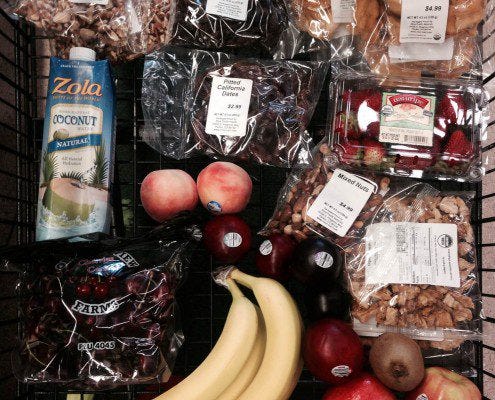
Shot of our shopping basket yesterday for a couple of days. Albertsons has some great selection, far better than what we expected! Lots of plastic packaging, which bums us out, but what can ya do sometimes?
As for electrolytes, we carry powdered magnesium citrate plus salt and mix that with water or juice. Coconut water is great too. No bonking or cramping yet, so it’s working great, even on long, hot days. Chelsea has a timer on her GPS that beeps every 10 minutes to remind her to hydrate, which is a fantastic way to stay on top of it. I’m a noise-hating grumpy old man and so I don’t use a timer, but admit to swigging some water occasionally when I hear her beeper go off.

The lovely Waterton Lake and the Prince of Wales Hotel on its shore. We opted for a free basement at a host's instead!
What’s the Hardest Thing About Bike Touring?
For me, it’s taking things one day at a time and not getting wrapped up in distance-mongering or my ego when I talk to some crusher 20 year old riding solo and doing 100 miles per day. Luckily, all I do is remind myself that they are rushing to get back before school starts and that riding 10+ hours a day for months is a grind.
Physically, the pedaling has gone better than expected! Our legs are steely strong and it is amazing that our bodies heal overnight and are ready to take the punishment anew every day, even as our minds say “stay in bed, you crazy cycling monkeys!” The toughest thing and most common reason for calling it a day is, as expected, sore butts, as there has been some chafing of late. ‘Nuf said about that - nothing petroleum jelly and a new saddle (mailed ahead and installed at a host’s house) for Chelsea can’t fix. We expected to deal with hurting derrieres, so this is just part of the journey. We shall persevere!

Down in the earth with the wheat, dirt and Chelsea cruising a back highway near the headwaters of the Missouri River. Lewis and Clark passed right by this area by Ft. Benton.
All in all, each day is a different logistical challenge. What to eat, where to stay, where to go, which Hells Angel to talk to in Glacier. We're having an awesome time and the fresh daily terrain keeps it interesting, but I admit it feels like we have no free time and energy levels are just high enough at the end of a day to handle the daily basics that keep us from turning into wild-eyed savages attacking hikers for granola bars and washing our faces in oily puddles. That said, finding time (and power/wifi) to write or engage in other projects is proving tough. Which is fine, even if it annoys me. Life ain’t too bad, and we are doing exactly what we set out to do, which is ride to the east coast. I didn't except hours of down time.
And so, with a slight reroute to our plans, onward toward the Badlands of South Dakota we roam!
Dakota

Wheat frames a hazy, fiery sunset in central Montana. Smoke from the fires in Washington made air quality bad for a couple days.
